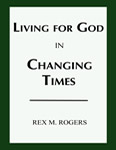The cross, which humanity meant for evil, was a simple wooden construction, yet God meant it for good and it became a worldwide icon of sacrifice, Yes, but even more of Hope.
Hi, I’m Rex Rogers and this is episode #109 of Discerning What Is Best, a podcast applying unchanging biblical principles in a rapidly changing world, and a Christian worldview to current issues and everyday life.
You remember the Old Testament story of Joseph and his brothers?
When Joseph was a youth, his older brothers became jealous at how their father favored him, and eventually, in an unbelievable pique of evil arrogance they plotted to kill him but then thought better of shedding blood and sold Joseph into slavery to a passing caravan of Ishmaelites heading down into Egypt (Gen. 37).
Over the next several years in servitude, then in prison, the Lord protected and blessed Joseph, positioning him for the time he’d be ready to interpret Pharaoh’s dreams about seven fat cows and seven skinny cows portending seven years of plenty followed by seven years of famine in Egypt (Gen. 41).
Pharoah showed his gratitude by wisely promoting Joseph from prison to second-in-command of all Egypt, in charge of storing grain during the fat years to be ready for use during the coming seven lean years. In the midst of this regional scarcity, Joseph’s father, Jacob, sent his sons to Egypt to trade for grain, and you guessed it, they meet their long lost and presumed dead brother, Joseph, now one of the most powerful men in the world.
There’s more to the story, but eventually after Jacob dies, the brothers approach Joseph in abject fear, asking for forgiveness, “then came and threw themselves down before him, (and they said) ‘We are your slaves,’ (Gen. 50:18).
But Joseph said to them “You intended to harm me, but God intended it for good to accomplish what is now being done,” (Gen. 50:19-20).
This is the key to this true story. What human beings mean for evil God can turn to good.
I can think of no better example of this biblical teaching than this than the crucifixion cross. This simple piece of carpentry was designed as a gruesome and horrific tool of excruciating suffering, torture, and shame leading to death. But in the case of the Savior Jesus’s cross, it has become an international symbol of redemption and hope.
“The cross is the central image or symbol of Christianity…Many Christians wear a cross around their neck or on their lapel as a badge that identifies them publicly as Christians. Some crosses are elaborate and expensive works of art, while others are very simple.”
Some wear crosses as identification, while some wear it as decoration, but wear it they do. In fact, in all likelihood there is not a day goes by in which there aren’t thousands wearing a cross in some manner, now even as tattoos.
“The startling transformation of the cross as a symbol came about through Jesus’ death and resurrection. We must remember always that the passion predictions in the Gospels are also resurrection predictions: each one ends with a mention of Jesus’ resurrection. Nevertheless, without the cross there would be no resurrection.
The cross as the central Christian symbol takes in the entire paschal mystery and issues in the resurrection and exaltation of Jesus.”
I have known of people who see the cross only as an horrendous abomination, something so disgusting and threatening it should never be displayed, much less celebrated. I respect their point of view, though I do not agree.
To me, the cross is both a symbol of bloodshed, and a symbol of blood sacrificed for the sins of the world.
The cross is a symbol of death and defeat but also a symbol of resurrection and victory,
a symbol of punishment, but a symbol of redemption and reconciliation,
a symbol of destruction, and a symbol of life eternal,
a symbol of suffering, and a symbol of hope,
a symbol of hate or judgment, and a symbol of love and forgiveness,
a symbol of the worst news possible, and a symbol of the Gospel, the Good News,
a symbol of Christ himself and of the faith of Christians.
“Before the time of the emperor Constantine in the 4th century, Christians were extremely reticent about portraying the cross because too open a display of it might expose them to ridicule or danger.
After Constantine converted to Christianity, he abolished crucifixion as a death penalty and promoted, as symbols of the Christian faith, both the cross and the chi-rho monogram of the name of Christ. The symbols became immensely popular in Christian art and funerary monuments from c. 350.”
“The crucifix, a model of the Christian cross upon which is a depiction of the crucified Christ” has been popular for centuries, especially for the Roman Catholic Church. Early Christians avoided realistic portrayal of his suffering, while by the 9th Century, artists stressed realistic aspects of Christ’s suffering and death. “Reformed churches resisted such use of the cross until the 20th century, when ornamental crosses on church buildings and on communion tables began to appear.”
Now, I prefer the empty cross over the crucifix, primarily because it’s very emptiness is a loud proclamation of victorious and glorious hope, both now and eternally.
Remarkable things have occurred relative to the cross. “The original 9/11 cross—a perfectly proportioned cross formed from the steel girders of the previously standing Twin Towers—was found in the wreckage of the Twin Towers and subsequently mounted on the site Oct. 15, 2006, where it stayed until it was moved July 23, 2011, to the September 11 Memorial and Museum at the former World Trade Center site across the street.” It remains today a statement of hope.
What human beings mean for evil God can turn to good.
Consider the Diaspora. “The first use of the word diaspora is found in John 7:35 in reference to the dispersed Jews living among the Greeks. In Acts 8:1-4 it is the Jewish Christians who were scattered or dispersed as a result of the stoning of the first martyr Stephen. By Acts 11:19, we again find use of this term in connection with scattered Jewish Christians, with some beginning to share the gospel message with Gentiles. James is addressed "To the twelve tribes in the Dispersion" (James 1:1). However, in this context the audience consists of Jewish Christians who lived in a variety of locations. First Peter 1:1 also addresses scattered peoples: "To those who are elect exiles of the Dispersion in Pontus, Galatia, Cappadocia, Asia, and Bithynia." In Peter's case, he wrote to both Jewish and Gentile Christians living in these areas, revealing that in some cases this word was being used in a new sense to include the scattered people of God from a Christian perspective.”
Early Christians fled in the face of persecution, but while the persecution was intended to squelch the growth of Christianity, it had the opposite effect, scattering believers to the four corners of the earth. What human beings mean for evil God can turn to good.
What are we to think of America’s current social chaos? In the face of moral upheaval are we to hide in bunkers, withdraw to isolated Christian communes, throw in the towel? Or are we to go “into the world” while being “not of the world” as we are commanded in John 17? If the current culture’s pell-mell rush to nihilism is a result of self-absorption, sin, and Satan, is it also perhaps in the providence of God our opportunity to shine the Light brighter in the midst of darkness? What people meant for evil, God meant for good.
In 2 Corinthians, the Apostle Paul reminded us, “Therefore, since through God’s mercy we have this ministry, we do not lose heart. Rather, we have renounced secret and shameful ways; we do not use deception, nor do we distort the word of God. On the contrary, by setting forth the truth plainly we commend ourselves to everyone’s conscience in the sight of God.”
Allow me to read that phrase again: “by setting forth the truth plainly we commend ourselves to everyone’s conscience in the sight of God.” Our task, our opportunity in the face of increasing false religions and moral decadence is that we can be ambassadors of reconciliation (2 Cor. 5:11-21). We can be truth-tellers.
The Apostle Paul continues: “The god of this age has blinded the minds of unbelievers, so that they cannot see the light of the gospel that displays the glory of Christ, who is the image of God. For what we preach is not ourselves, but Jesus Christ as Lord, and ourselves as your servants for Jesus’ sake. For God, who said, “‘Let light shine out of darkness,’ made his light shine in our hearts to give us the light of the knowledge of God’s glory displayed in the face of Christ,” (2 Cor. 4).
The cross represents the Good News of Jesus Christ, and we get to communicate this Good News, knowing that what people mean for evil, God can turn to good.
Well, we’ll see you again soon. This podcast is about Discerning What Is Best. If you find this thought-provoking and helpful, follow us on your favorite podcast platform. Download an episode for your friends. For more Christian commentary, check my website, r-e-x-m as in Martin, that’s rexmrogers.com.
And remember, it is for freedom that Christ has set us free. Stand firm.
© Rex M. Rogers – All Rights Reserved, 2023
*This podcast blog may be reproduced in whole or in part with a full attribution statement. Contact me or read more commentary on current issues and events at www.rexmrogers.com/, or connect with me at www.linkedin.com/in/rexmrogers.


